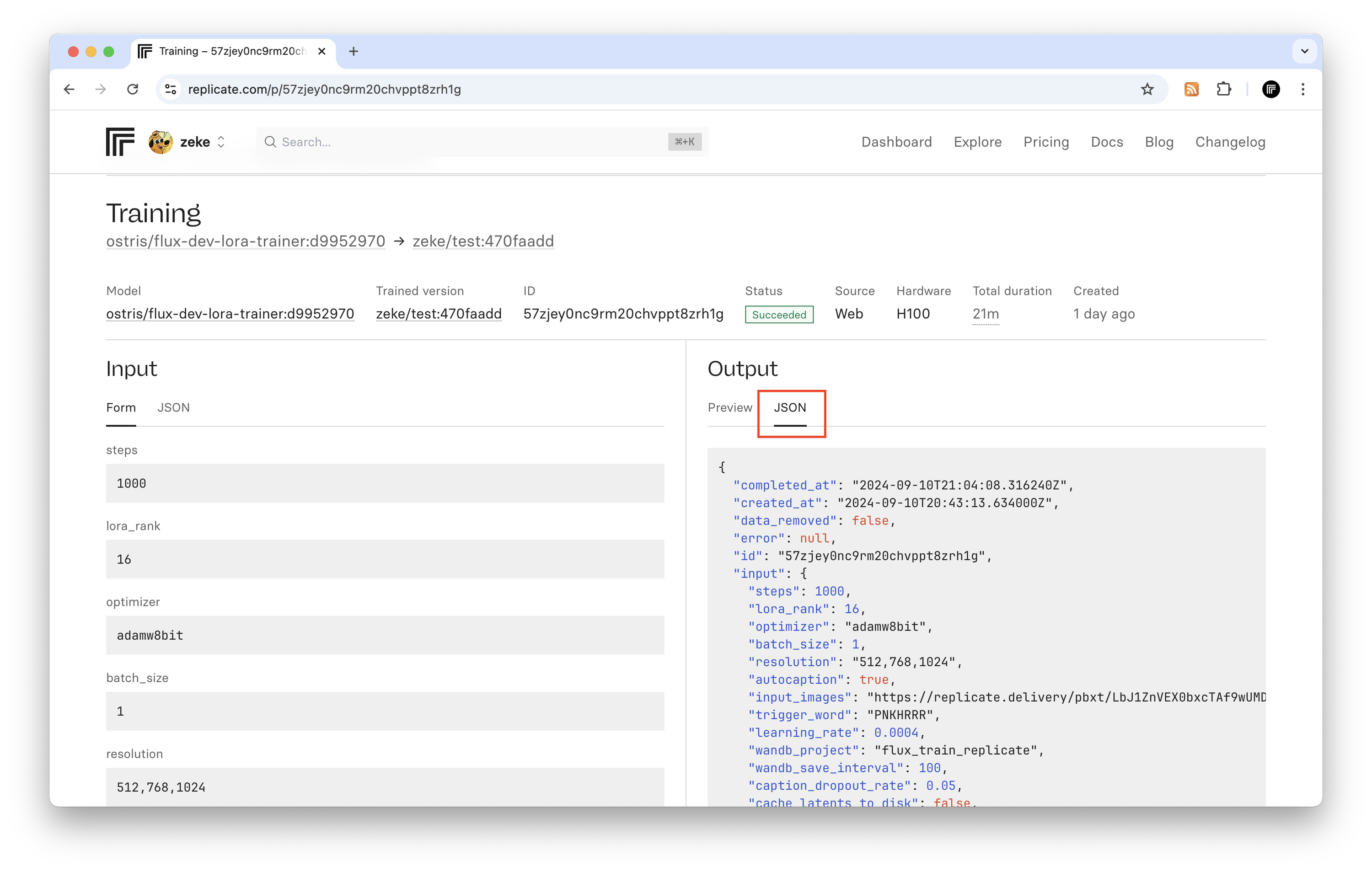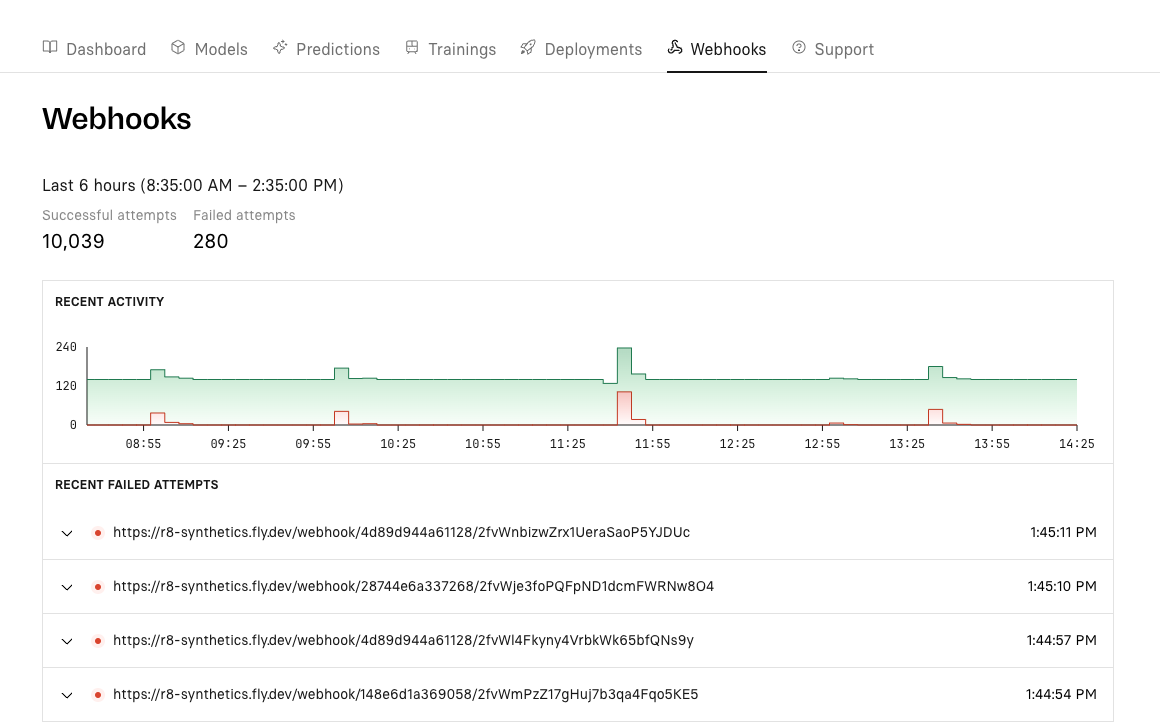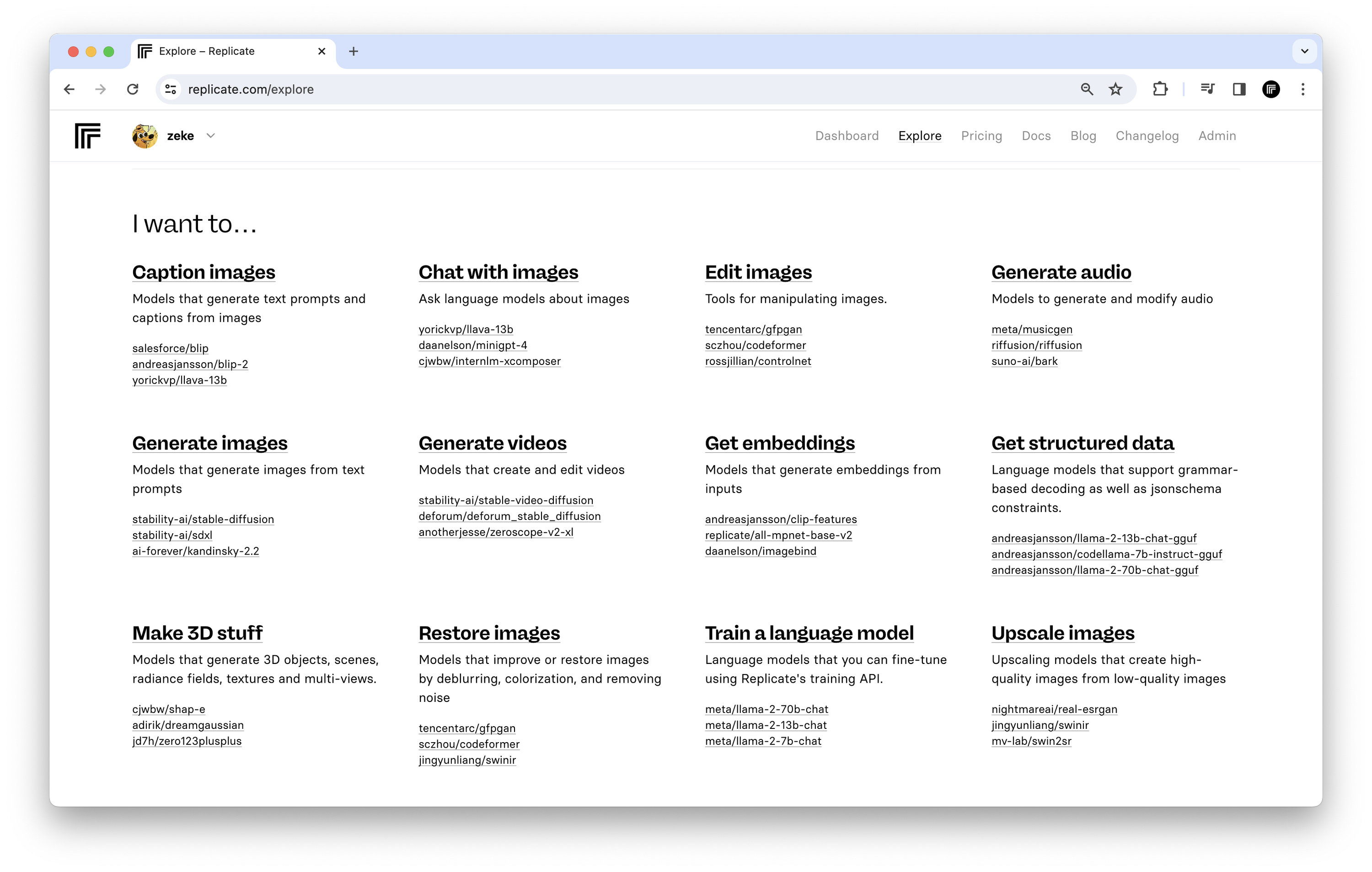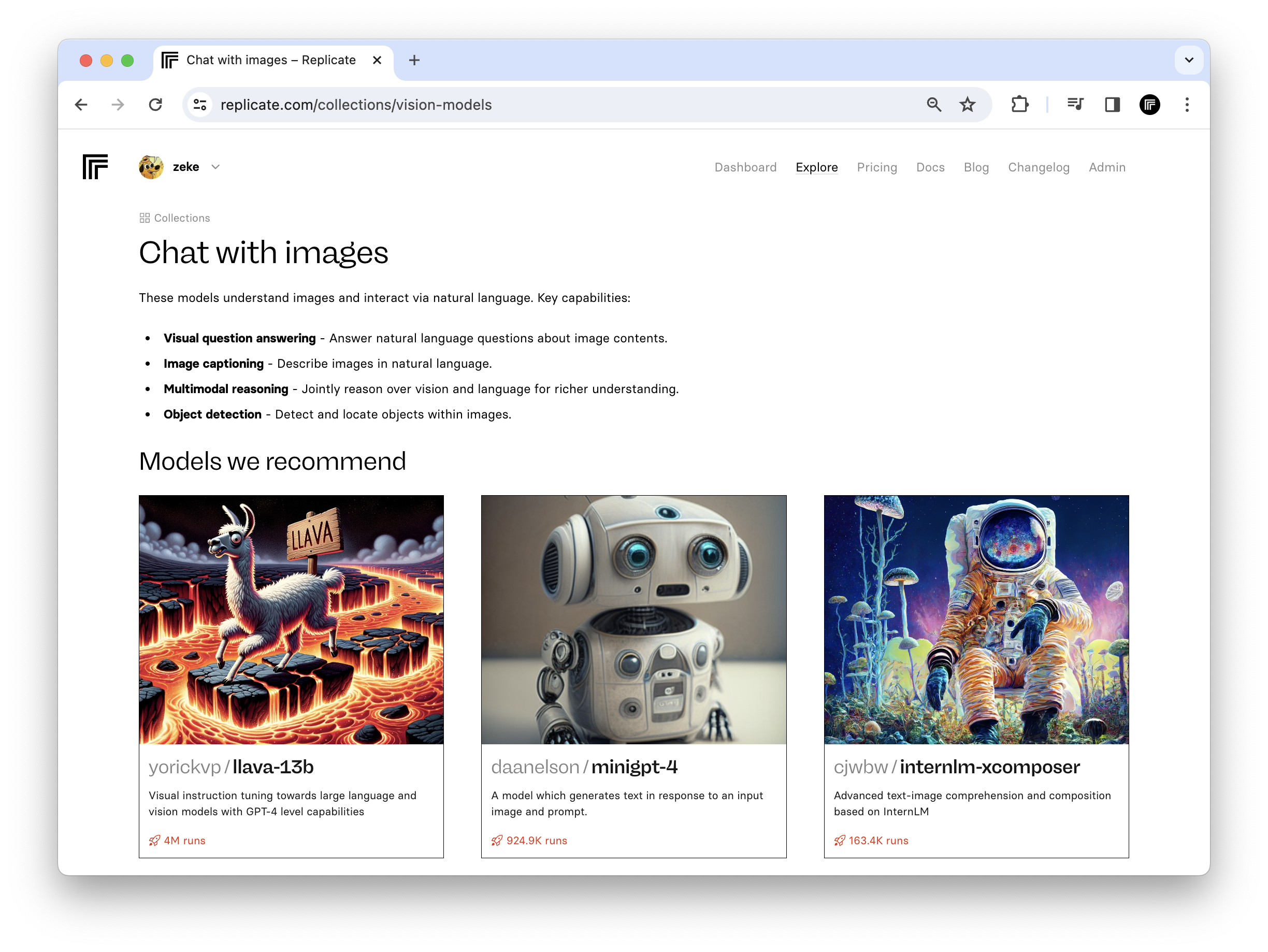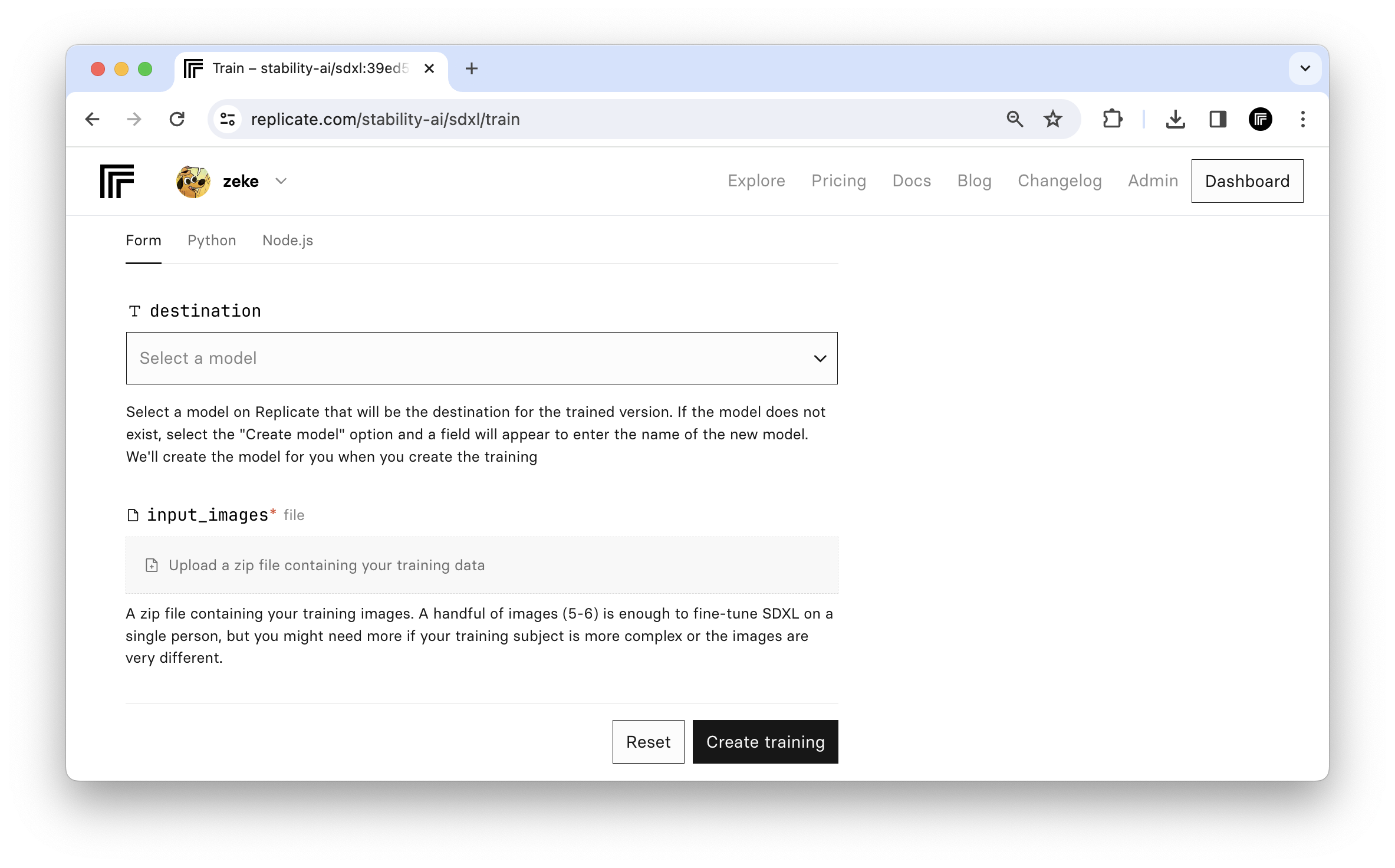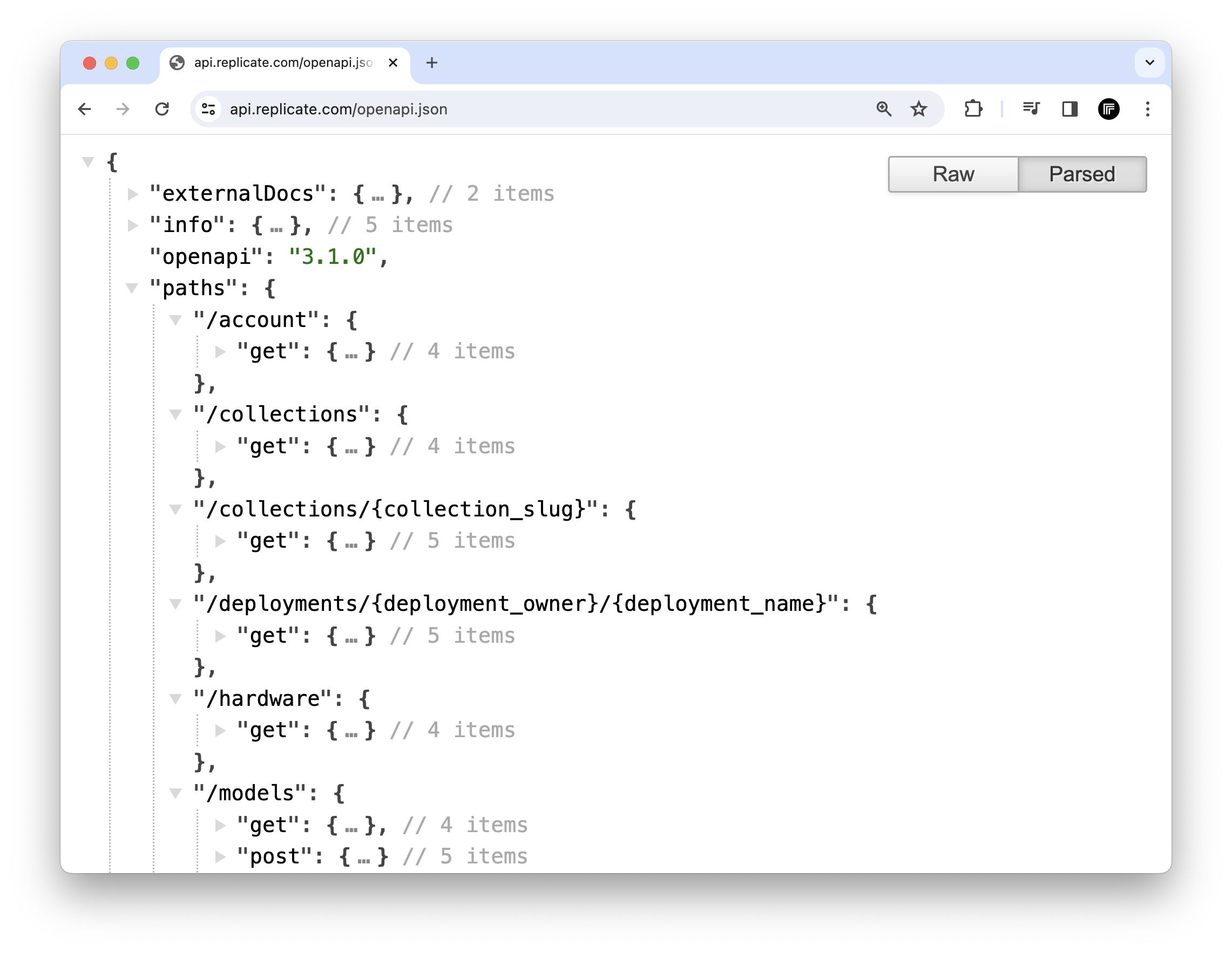Changelog
-
The little things, week ending November 22, 2024
November 22, 2024
Playground
- Added FLUX1.1 [pro] ultra to default models, along with a number of new models
- Improved image loading on playground
- Optimizations when rendering many images, especially with larger images files (like with black-forest-labs/flux-1.1-pro-ultra)
- Better handling of enums of numbers in the playground
- Fixed a bug that cropped images in the grid
- Fixed a bug where an image may have been prematurely flagged as downloadable
- Added the ability to invert masks after inpainting, undo strokes, and to use the mouse wheel to alter brush resizing
Web
- Improved signposting when you first sign up and land on the dashboard
- Moved thumbnail images to the right in the prediction list to make browsing easier
- Improved navigation rendering across Replicate
- Added the ability to show preview pricing for hardware on pricing
- Improved the onboarding flow to make the steps clearer
- Improved invoice JSON download visibility
- Improved discoverability of the new playground from model detail pages
- Updated terms and privacy pages
Platform
- Added support for per-video pricing
- Added support for L40S GPUs
Docs
- Published a new doc about OpenAPI schemas for the HTTP API and all models.
-
The little things, week ending November 8, 2024
November 8, 2024
Runtime
- Rollback of data URLs in the new sync API.
Playground
- Added file picker to playground to simplify file uploading
- Added Stable Diffusion 3.5L to the default models
- Added Recraft V3 to the default models
- Made keyboard shortcuts clearer between different operating systems
- Added download link to the grid in the playground
- Fixed an issue where predictions were incorrectly being flagged as ephemeral
- Added model card to the playground, to give more context on models
Web
- Made keyboard shortcuts clearer between different operating systems
- Improved the rendering and support of legacy blog posts
- Updated API examples to better represent different return types
- Made switching between themes easier across the site
- Made the placement of “add to example” buttons for model owners on predictions clearer
- Ongoing improvements to dark mode across web
- Updated sitemaps for web
- Resolved an issue where certain pages would redirect to add a trailing slash to the URL
Docs
- Added HTTP API docs for new synchronous predictions.
- Updated sitemaps for docs
-
A fond farewell to Python 3.7
November 7, 2024
Replicate will stop supporting models built with Python 3.7 at 12:00 PM UTC (Coordinated Universal Time) on Friday, November 15th.
Python 3.7 was declared end-of-life in late June 2023. Since then, we’ve continued running models built with it to give model maintainers time to migrate to newer Python versions.
Although we would like to continue running these models indefinitely, we must prioritize the security needs of our customers. After Python 3.7 support ends, requests to affected models will fail with a 400-level error with an explanation.
Please update your models to a newer Python version before this date to avoid any interruptions, and let us know if you have questions or need help updating your models.
-
The little things, week ending October 25, 2024
October 25, 2024
Runtime
- Dropped support for running Python 3.6 and 3.7 models
- Dropped support for pushing Python 3.8 models, but existing ones will still run
- Added support for Pydantic 2
Playground
- Added inline inpainting to the playground
- Added video to the playground
- Added more granular grid sizes to the playground
- Fixed a bug that caused double submissions on the playground form
- Added better handling for unsupported outputs on the playground
- Improved focus states in the grid and list view for the playground
- Added the ability to delete items from the playground grid
- Made keyboard shortcuts more visible for the playground
- Improved scrolling performance for playground
Web
- Relaunched the about page, including job roles and applications
- Better handle longer queue lengths for deployment metrics
- Fixed a display bug with pricing on models for signed out users
- Fixed some z-index weirdness for signed out users
- Improved copy / saving of streamed images on web
- Fixed bugs in per-model API endpoint documentation
- Handled models without a cover image better, especially on social media
- Reduced inconsistencies for input schema tables between model versions and the model API tab
- Improved display of plural units in the model pricing table
- Added sorting by name and cost to invoices, and the ability to download invoices as JSON
- Improved handling of multi file strings on the model page
- Fixed bug on the model detail page when pasting JSON
- Handled an edge case where the state of a model didn’t match visually
- Fixed a few cases where the colors were wrong in dark mode
Docs
- Moved guides into docs
- Updated selection color on our docs to improve accessibility
- Improved readability for monospaced fonts on docs
- Handled image caching for docs better
-
Dark mode
October 10, 2024
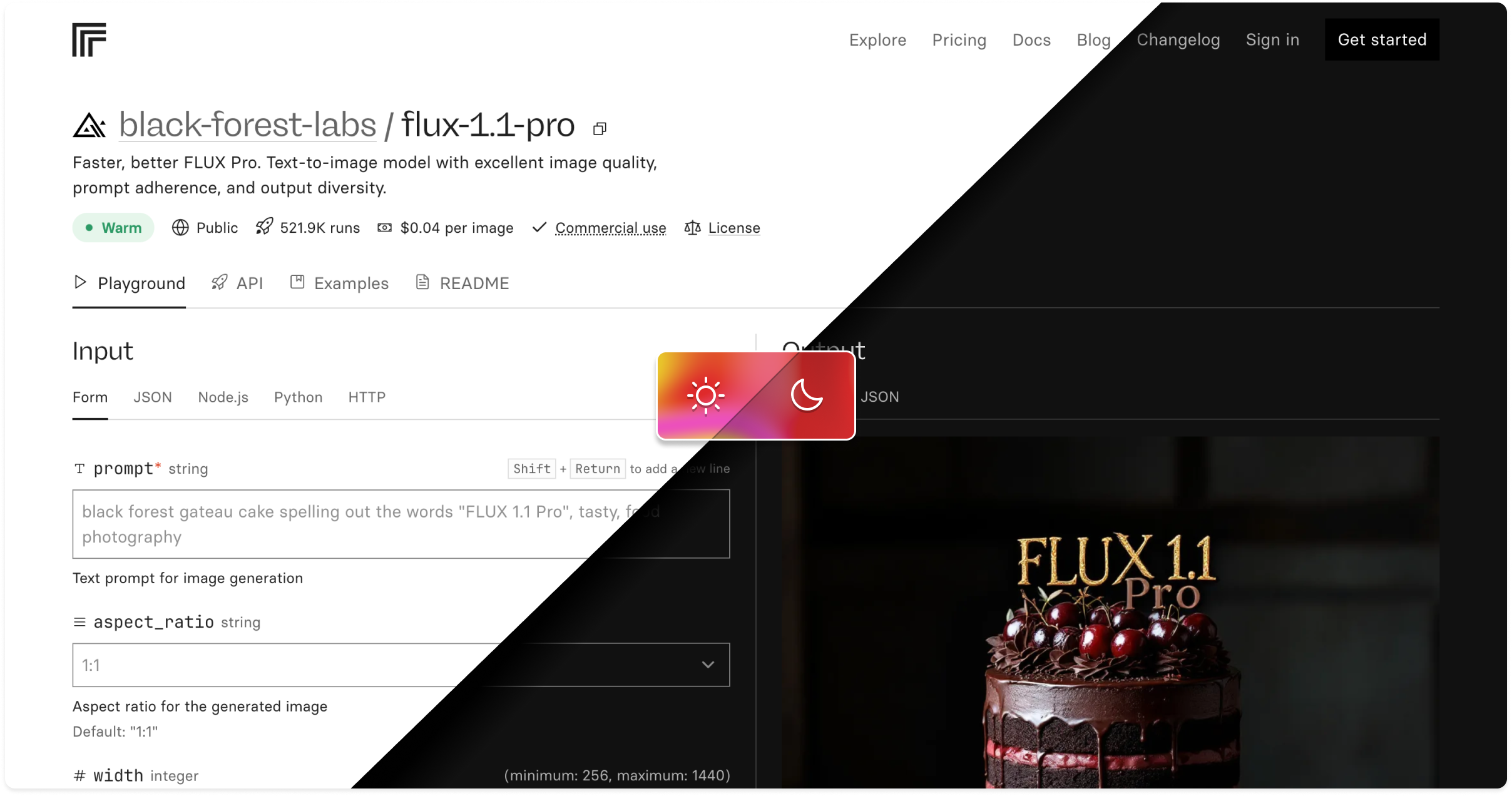
Finally. You can switch it in the footer.
-
Playground (beta)
October 10, 2024
Playground is a way to quickly try out and compare the output of models on Replicate.
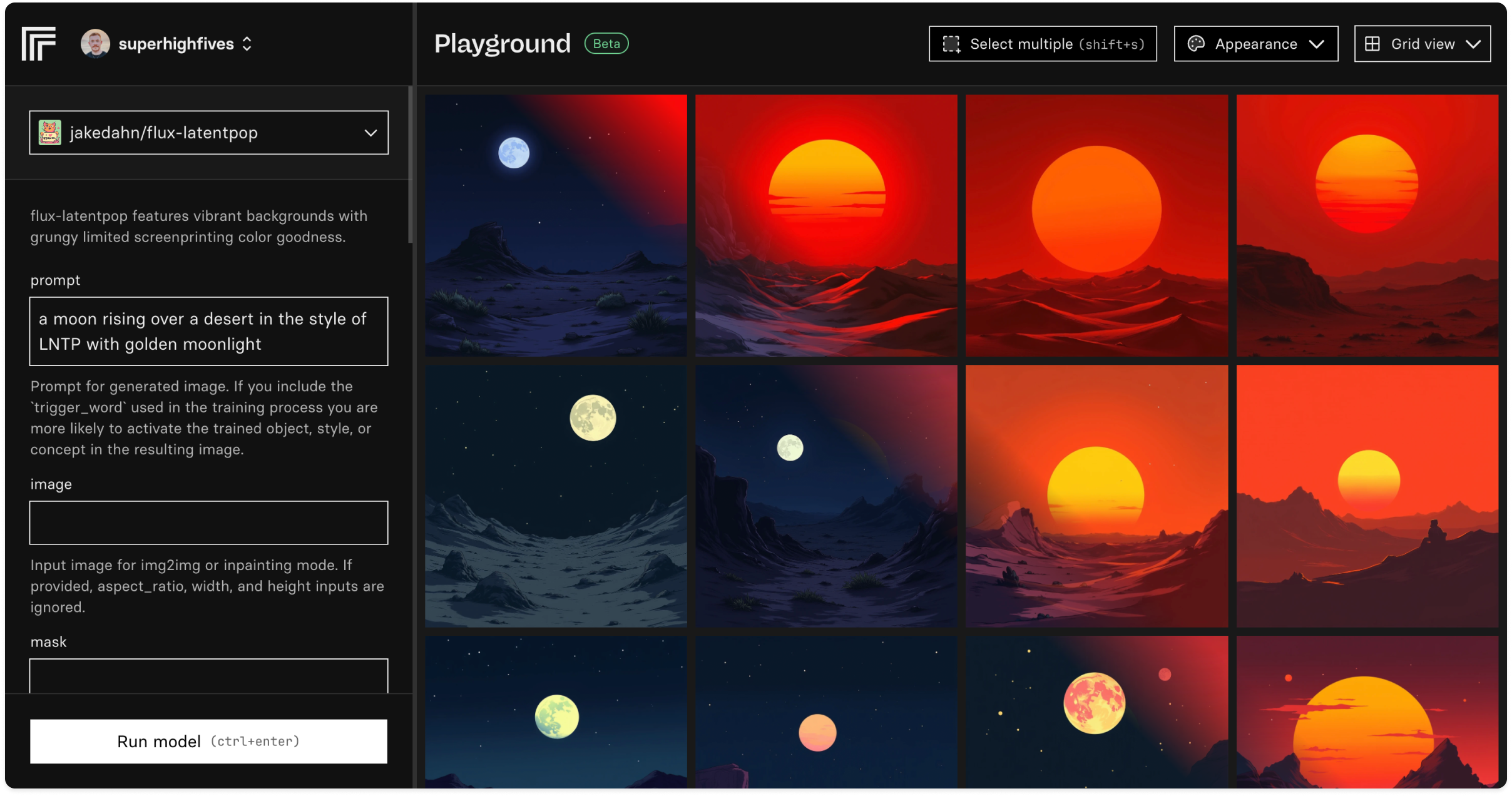
You can:
- Create grids of images and compare them
- Grab the code to generate the images with Replicate
- Test different models, prompts, and settings, side-by-side
- Keep a scrapbook and export images in bulk
Playground is currently in beta, and works with any FLUX and related fine-tunes. Try it out at replicate.com/playground.
We’d love to hear what you think. Send your feedback to playground@replicate.com.
-
New documentation
October 10, 2024
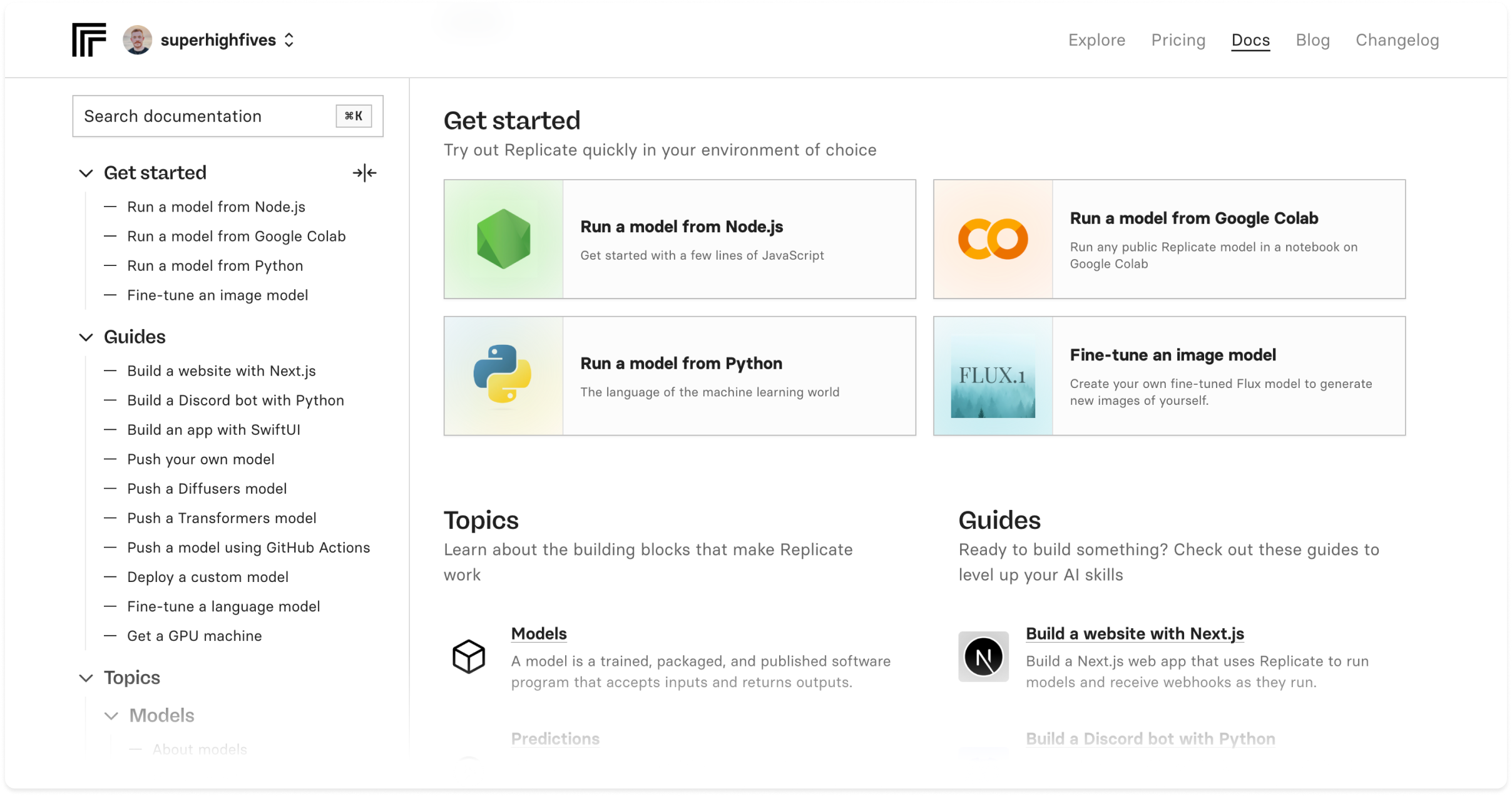
Documentation now has a cleaner design, better navigation, and lots of new content to help you build with Replicate.
It’s organized into four sections:
- Getting started: tutorials to help you get up and running quickly
- Guides: step-by-step instructions and deeper dives into specific topics
- Topics: detailed explanations of how Replicate works
- Reference: complete documentation for Replicate’s client libraries and API
We’ve added dozens of new code samples, detailed guides for common use cases, and an expanded API reference.
Take a look at replicate.com/docs.
-
Synchronous API
October 9, 2024
Our client libraries and API are now much faster at running models, particularly if a file is being returned.
The API now just returns the response immediately. Before, you would have to poll to get the result.
If you’re using the Node.js or Python client libraries, you don’t have to worry about this. Just upgrade to the latest version and it gets faster. Also, instead of returning HTTP URLs, they now return file objects, which makes it much easier to write them to storage or pass to HTTP responses.
Node.js
Install the beta version of the client library:
npm install replicate@latestThen run the model:
import Replicate from "replicate"; import fs from "node:fs"; const replicate = new Replicate(); const [output] = await replicate.run("black-forest-labs/flux-schnell", { input: { prompt: "astronaut riding a rocket like a horse" }}); // It now returns a file object fs.writeFileSync("my-image.webp", output); // Or, you can still get an HTTP URL console.log(output.url())Python
Update the client library:
pip install --upgrade replicateThen run the model:
[output] = replicate.run( "black-forest-labs/flux-schnell", input={"prompt": "astronaut riding a rocket like a horse"} ); with open('output.webp', 'wb') as file: file.write(output.read()) print(output.url)The client libraries returning file objects is a breaking change so be careful when you upgrade your apps.
HTTP API
If you’re using the HTTP API for models or deployments, you can now pass the header
Prefer: wait, which will keep the connection open until the prediction has finished:curl -X POST <https://api.replicate.com/v1/models/black-forest-labs/flux-schnell/predictions> \\ -H "Authorization: Bearer $REPLICATE_API_TOKEN" \\ -H "Prefer: wait=10" \\ -d '{"input": {"prompt": "a cat riding a narwhal with rainbows"}}'Output:
{ "id": "dapztkbwgxrg20cfgsmrz2gm38", "status": "processing", "output": ["https://..."], }By default it will wait 60 seconds before returning the in-progress prediction. You can adjust that by passing a time, like
Prefer: wait=10to wait 10 seconds.Take a look at the docs on creating a prediction for more details.
-
Large log outputs might be truncated
October 9, 2024
Predictions or trainings that log particularly large volumes of information may now have their logs truncated. This helps us manage load on our platform and is a restriction we may lift in future.
For now, you’ll always get the first few lines of your logs – which might contain important information about inputs, seed values, etc. – and the most recent logs.
-
Time limit for sharing predictions
September 17, 2024
To improve API performance and speed up database queries, we are cleaning out old predictions.
From now on, you’ll only be able to share predictions made in the web playground for up to 60 days after they’re created.
If you’ve already shared a prediction, don’t worry - it will still be accessible to others even after 60 days.
-
View training outputs on the web
September 11, 2024
The training detail page on the website now has a JSON tab, so you can see all the metadata and outputs from your trainings, including the URL of your generated weights file.
To view all your trainings, go to replicate.com/trainings
-
API for searching public models
July 24, 2024
Replicate’s API now has an endpoint for searching public models.
To use it, make a QUERY HTTP request using your search query as the plaintext body of the request:
curl -s -X QUERY \ -H "Authorization: Bearer $REPLICATE_API_TOKEN" \ -H "Content-Type: text/plain" \ -d "face" \ https://api.replicate.com/v1/modelsThe response will be a paginated JSON object containing an array of model objects:
{ "next": null, "previous": null, "results": [ { "url": "https://replicate.com/acme/hello-world", "owner": "acme", "name": "hello-world", "description": "A tiny model that says hello", "visibility": "public", "github_url": "https://github.com/replicate/cog-examples", "paper_url": null, "license_url": null, "run_count": 5681081, "cover_image_url": "...", "default_example": {...}, "latest_version": {...} } ] }For more details, check out the HTTP API reference docs.
You can also the download metadata for all public models on Replicate using the list public models API if you need more fine-grained control or want to build your own implementation of model search.
-
Streams always available, stream parameter deprecated
July 15, 2024
We’ve made streaming a tiny bit easier and simplified our API.
When we first launched streaming for language models you had to pass
"stream": truewith your request to enable it. Adoption of streaming has been great, with about one third of requests to compatible models requesting a stream, and our streaming infrastructure is more robust now than it was when we first launched it. This means we’re now in the position to just stream everything by default if the model supports it.So you no longer need to pass
"stream": truewith your prediction request to get back a stream URL – if the model supports streaming, you’ll always get one back.We’ve deprecated the field, but it’s still valid to pass it. If you do continue to pass
"stream": truethen if the model supports streaming it has no effect. And if the model doesn’t support streaming we’ll keep the current behaviour of responding with a 422. -
Secret inputs for models
June 7, 2024
We’ve added a way to securely pass sensitive values to models.
In Cog v0.9.7 and later, you can annotate an input with the
Secrettype to signify that an input holds sensitive information, like a password or API token.from cog import BasePredictor, Secret class Predictor(BasePredictor): def predict(self, api_token: Secret) -> None: # Prints '**********' print(api_token) # Use get_secret_value method to see the secret's content. print(api_token.get_secret_value())Replicate treats secret inputs differently throughout its system. When you create a prediction on Replicate, any value passed to a
Secretinput is redacted after being sent to the model.Before

After

Caution: Passing secret values to untrusted models can result in unintended disclosure, exfiltration, or misuse of sensitive data.
-
Disable API tokens
June 4, 2024
You can now disable API tokens from the web. This is useful if you accidentally leaked your token and want to prevent unauthorized use of the token.
To view and manage your tokens, go to replicate.com/account/api-tokens.

-
RSS and Atom feeds
May 28, 2024
We now publish RSS and Atom feeds for our blog, changelog, and platform status site. You can subscribe to these feeds to get updates about new product features, as well as platform incidents
- https://replicatestatus.com/feed
- https://replicate.com/changelog/rss
- https://replicate.com/changelog/atom
- https://replicate.com/blog/rss
- https://replicate.com/blog/atom
If you’re using Slack, you can use Slack’s RSS app to subscribe to these feeds and get notifications right in your team’s Slack workspace.
-
Delete stuff
May 21, 2024
You can now delete models, versions, and deployments using the web or the HTTP API.
Deleting models
You can delete a model directly from the web on the model settings page. You can also delete a model programmatically using the
models.deleteHTTP API.There are some restrictions on which models you can delete:
- You can only delete models you own.
- You can only delete private models.
- You can only delete models that have no versions associated with them. You’ll need to delete any versions first before deleting the model.
Deleting model versions
You can delete a model version directly from the web using the nav in the header of the model versions page. You can also delete a model version programmatically using the
versions.deleteHTTP API.The following restrictions apply to deleting versions:
- You can only delete versions from models you own.
- You can only delete versions from private models.
- You cannot delete a version if someone other than you has run predictions with it.
- You cannot delete a version if it is being used as the base model for a fine tune/training.
- You cannot delete a version if it has an associated deployment.
- You cannot delete a version if another model version is overridden to use it.
Deleting deployments
You can delete a deployment directly from the web on the deployment settings page. You can also delete a deployment programmatically using the
deployments.deleteHTTP API.The following restriction applies to deleting deployments:
- You can only delete deployments that have been offline and unused for at least 15 minutes.
-
Docs and client library support for webhook verification
May 14, 2024
A webhook is an HTTP POST from an unknown source. Attackers can impersonate services by simply sending a fake webhook to an endpoint. Replicate protects you from this attack by signing every webhook and its metadata with a unique key for each user or organization. You can use this signature to verify that incoming webhooks are coming from Replicate before you process them.
Today we improved our documentation and client library support for webhooks, so you can securely verify webhooks in your existing application without having to write your own validation logic:
-
Search for deployments
May 2, 2024
The Replicate website has a search bar at the top of every screen that lets you fuzzy search for models, collections, and pages.
We’ve now added deployments to the search results, so you can quickly jump right to one of your deployments with fewer clicks.
Press
cmd-k(orctrl-kon Windows) to open the search and search for your deployment by name:
-
Webhooks activity UI
May 2, 2024
We’ve added two new UI features to make your experience with webhooks better on Replicate.
On the prediction detail screen, if your prediction was made with webhooks, you’ll see an indicator that opens a sliding panel with the details and status of those webhooks.
There’s also a new “Webhooks” tab on the Dashboard where you’ll find a chart detailing 6 hours of recent webhook activity, as well as any failures that have occurred in that time period.
-
Improved validation for API prediction payloads
May 1, 2024
If you typo a field in the JSON request body when creating a prediction with the API, we will now tell you about it rather than silently accepting it.
Here’s an example showing the response you’ll get if you misspell
inputasinptu:$ curl -s -X POST \ -H "Authorization: Bearer $REPLICATE_API_TOKEN" \ -H 'Content-Type: application/json' \ -d '{ "version": "5c7d5dc6dd8bf75c1acaa8565735e7986bc5b66206b55cca93cb72c9bf15ccaa", "inptu": {"text": "Alice"} }' \ https://api.replicate.com/v1/predictions | jq .invalid_fields[ { "type": "required", "field": "", "description": "input is required" }, { "type": "additional_property_not_allowed", "field": "", "description": "Additional property inptu is not allowed" } ]Note that this validation only applies to top-level properties in the payload like
input,version,stream,webhook,webhook_events_filter, etc. -
T4 models now have more RAM
April 11, 2024
Until recently, models running on T4 GPUs would get 4 CPUs, 8 GB of RAM and 16 GB of GPU RAM. We got feedback from model authors that this caused issues with loading more than 8GB of weights into the GPU - it’s possible, but it requires writing more intricate code to stream weights from disk to GPU RAM without loading the whole weights into main RAM at once.
Starting today, T4 models can now use up to 16 GB of RAM. This should make it easier to make use of all of the GPU RAM on T4 GPUs. There is no pricing change for this upgrade.
You can see the resources available for each hardware type on our pricing page.
-
GitHub secret scanning
April 10, 2024
When working with secrets like API tokens, you should always store them in your app configuration (like environment variables) rather than directly in your codebase. Keeping sensitive information separate from your source code prevents accidental exposure.
This is a common and well-known security practice, but sometimes you slip up and accidentally include a secret in your codebase. That’s where GitHub security scanning comes in.
We’ve partnered with GitHub and are now members of their Secret scanning partner program, helping to keep your account safe. Whenever GitHub finds a Replicate API token in a public repository, they notify us so we can take proper steps to protect your account from unwanted use.
-
Bearer tokens
April 3, 2024
When using an HTTP API, a Bearer token is like a password that you specify in the
Authorizationheader of your HTTP requests to access protected resources.We’ve updated our API to support a standard
Bearerauthorization scheme rather than a custom/non-standard Token scheme. We’ve also updated our API docs and OpenAPI specification to use the new format:curl -H "Authorization: Bearer r8_...." https://api.replicate.com/v1/models/replicate/hello-worldThe old
Authorization: Token r8...format is still supported, so your existing API integrations will continue to work without any code changes. -
Deployments API
March 12, 2024
Deployments give you more control over how your models run. You can scale them up and down based on demand, customize their hardware, and monitor performance and predictions without editing your code.
Managing deployments was previously only possible on the web, but you can now also create, read, and update deployments using Replicate’s HTTP API.
Here’s an example API request that updates the number of min and max instances for an existing deployment:
curl -s \ -X PATCH \ -H "Authorization: Token $REPLICATE_API_TOKEN" \ -H "Content-Type: application/json" \ -d '{"min_instances": 3, "max_instances": 10}' \ https://api.replicate.com/v1/deployments/acme/my-app-image-generatorCheck out the API docs for deployments:
If you’re new to deployments, check out the getting started guide.
-
3D viewer for GLB outputs
February 19, 2024
Models like adirik/imagedream that output GLB files now have a web-based viewer, so you can explore the 3D output right in your browser.
The GLB format encapsulates textures, models, and animations into a single file which can be easily shared and used across platforms and devices. This makes it useful in web development, augmented reality projects, and game development.
If you’re working with AI models that produce PLY outputs, you can use a model like camenduru/lgm-ply-to-glb to convert PLY files to GLB.
There’s also a collection of models for making 3D stuff.
-
Task-oriented collections
February 16, 2024
We’ve updated our curated model collections to be more oriented around tasks like upscaling images, generating embeddings, or getting structured data from language models. This should make it easier to find the right models for the problems you’re trying to solve.
Each collection now also includes a more detailed summary of the kinds of tasks you can perform with models in that collection. For example, vision models can be used for all sorts of tasks like captioning images, answering questions about images, or detecting objects:
-
Webhook verification
February 6, 2024
Webhooks provide real-time updates about your predictions. You can specify an endpoint when you create a prediction, and Replicate will send HTTP POST requests to that URL when the prediction is created, updated, and finished.
Starting today, we now sign every webhook and its metadata with a unique key for each user or organization. This allows you to confirm the authenticity of incoming webhooks and protect against unauthorized access and replay attacks.
Learn how to verify incoming webhooks on our webhooks guide
-
Fine-tune SDXL from the web
January 19, 2024
In August 2023, we added an API for fine-tuning SDXL, Stability AI’s most powerful open-source image generation model. We made it easy to create your own custom models with just a handful of training images and a few lines of code, then generate new images in your own style. In the last few months, people have created lots of interesting SDXL fine-tunes.
You can now create SDXL fine-tunes from the web. Choose a name for your model, drag and drop a zip file of images, and kick off the training process, without writing any code.
To get started, visit replicate.com/stability-ai/sdxl/train
-
Compare image inputs to outputs
December 19, 2023
We’ve added a new slider component that makes it easier to compare image inputs to outputs. Drag the slider to the left and right to compare the “before and after” images.
This feature works for all models that take an input image and produce an output image, like image restoration models and upscalers.
-
Code snippets for every prediction
November 8, 2023
Every prediction on the web now includes code snippets for Node.js, Python, and other languages. This makes it easy to tinker with a model on the web, then grab some useable code and run with it.
To view these code snippets, click the language tabs under the Input heading on any model or prediction page:
Clicking one of these language tabs changes the page URL, which means you can also deep link to language-specific snippets for any model:
Here’s a five-minute video showing off how to use this new feature to run a model in the browser, then grab the code to run the model in your own project using Replicate’s API:
-
API for creating models
November 6, 2023
Replicate’s API now has an endpoint for creating models.
You can use it to automate the creation of models, including fine-tunes of SDXL and Llama 2.
cURL usage
Here’s an example that uses cURL to create a model with a given owner, name, visibility, and hardware:
curl -s -X POST -H "Authorization: Token $REPLICATE_API_TOKEN" \ -d '{"owner": "my-username", "name": "my-new-model", "visibility": "public", "hardware": "gpu-a40-large"}' \ https://api.replicate.com/v1/modelsThe response is a JSON object of the created model:
{ "url": "https://replicate.com/my-username/my-new-model", "owner": "my-username", "name": "my-new-model", "description": null, "visibility": "public", "github_url": null, "paper_url": null, "license_url": null, "run_count": 0, "cover_image_url": null, "default_example": null, "latest_version": null }To see all the hardware available for your model to run, consult our endpoint for listing hardware.
curl -s -H "Authorization: Token $REPLICATE_API_TOKEN" \ https://api.replicate.com/v1/hardware[ { "name": "CPU", "sku": "cpu" }, { "name": "Nvidia T4 GPU", "sku": "gpu-t4" }, { "name": "Nvidia A40 GPU", "sku": "gpu-a40-small" }, { "name": "Nvidia A40 (Large) GPU", "sku": "gpu-a40-large" } ]To compare the price and specifications of these hardware types, check out the pricing page.
JavaScript usage
We’ve added this new operation to the Replicate JavaScript client:
npm install replicate@latestThen:
import Replicate from "replicate"; const replicate = new Replicate(); // create a new model const model = await replicate.models.create( "my-username", "my-new-model", { visibility: "public", hardware: "gpu-a40-large" } ); console.log(model)Python usage
We’ve added this new operation to the Replicate Python client:
pip install --upgrade replicateThen:
import replicate model = replicate.models.create( owner="my-username", name="my-new-model", visibility="public", hardware="gpu-a40-large", ) print(model)Elixir usage
We’ve added this new operation to the Replicate Elixir client:
mix deps.update replicateThen:
iex> {:ok, model} = Replicate.Models.create( owner: "your-username", name: "my-model", visibility: "public", hardware: "gpu-a40-large" )API docs
Check out the HTTP API reference for more detailed documentation about this new endpoint.
-
Improved training detail pages
October 17, 2023
When you kick off a training process to fine-tune your own model, there’s a page you can visit to view the status of the training, as well as the inputs and outputs. We’ve made some recent improvements to those pages:
- The header now shows the base model and destination model you used when fine-tuning.
- Metadata about the training job is now diplayed above the inputs and outputs to make it easier to see the important details without having to scroll down the page.
- We’ve added code snippets you can copy and paste to run your new fine-tuned model.
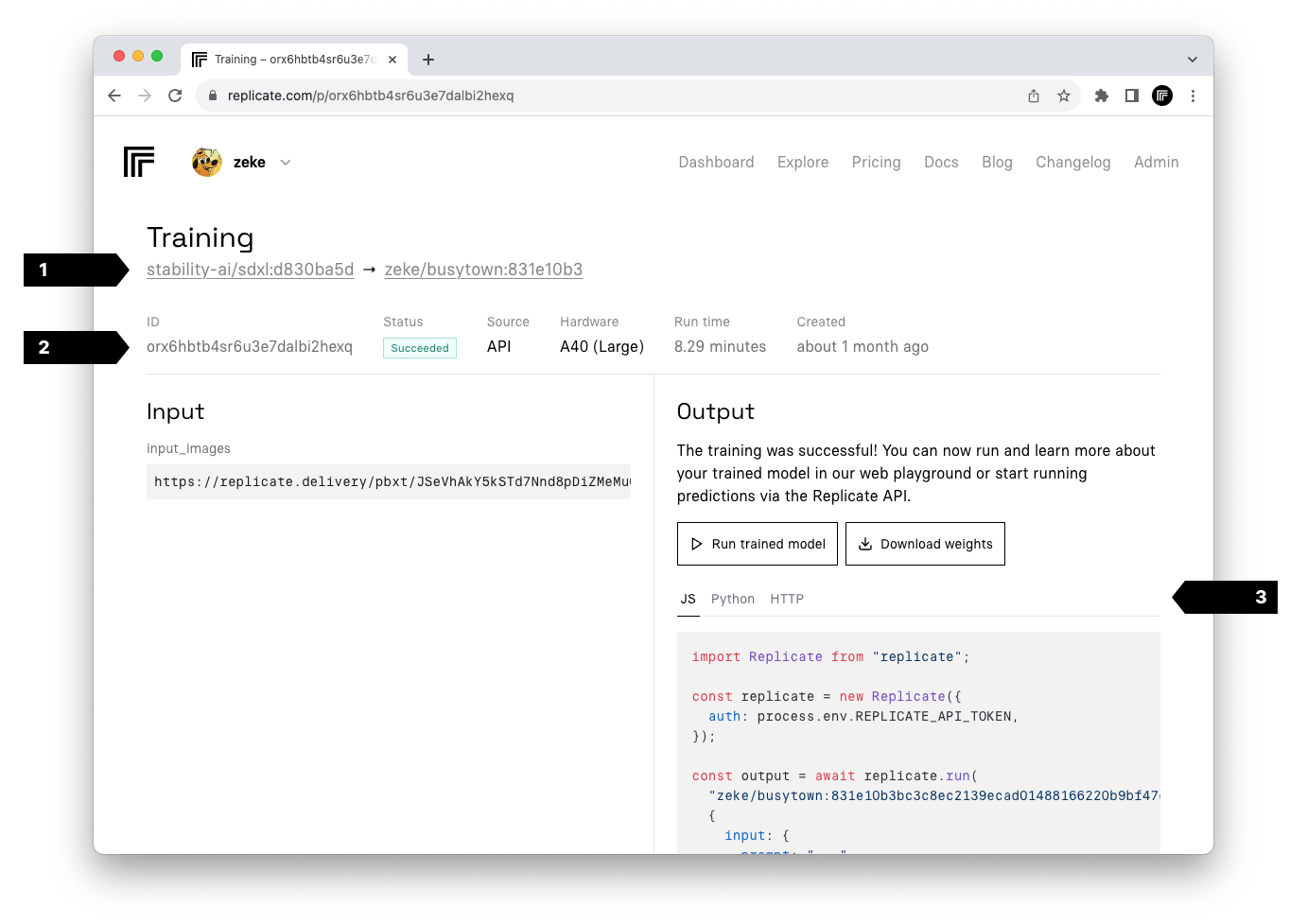
-
Prediction parameters as JSON
October 9, 2023
You can now view prediction parameters as JSON from the prediction detail page.
This improves the workflow for experimenting in the web interface and then transitioning to making predictions from the API, using code.
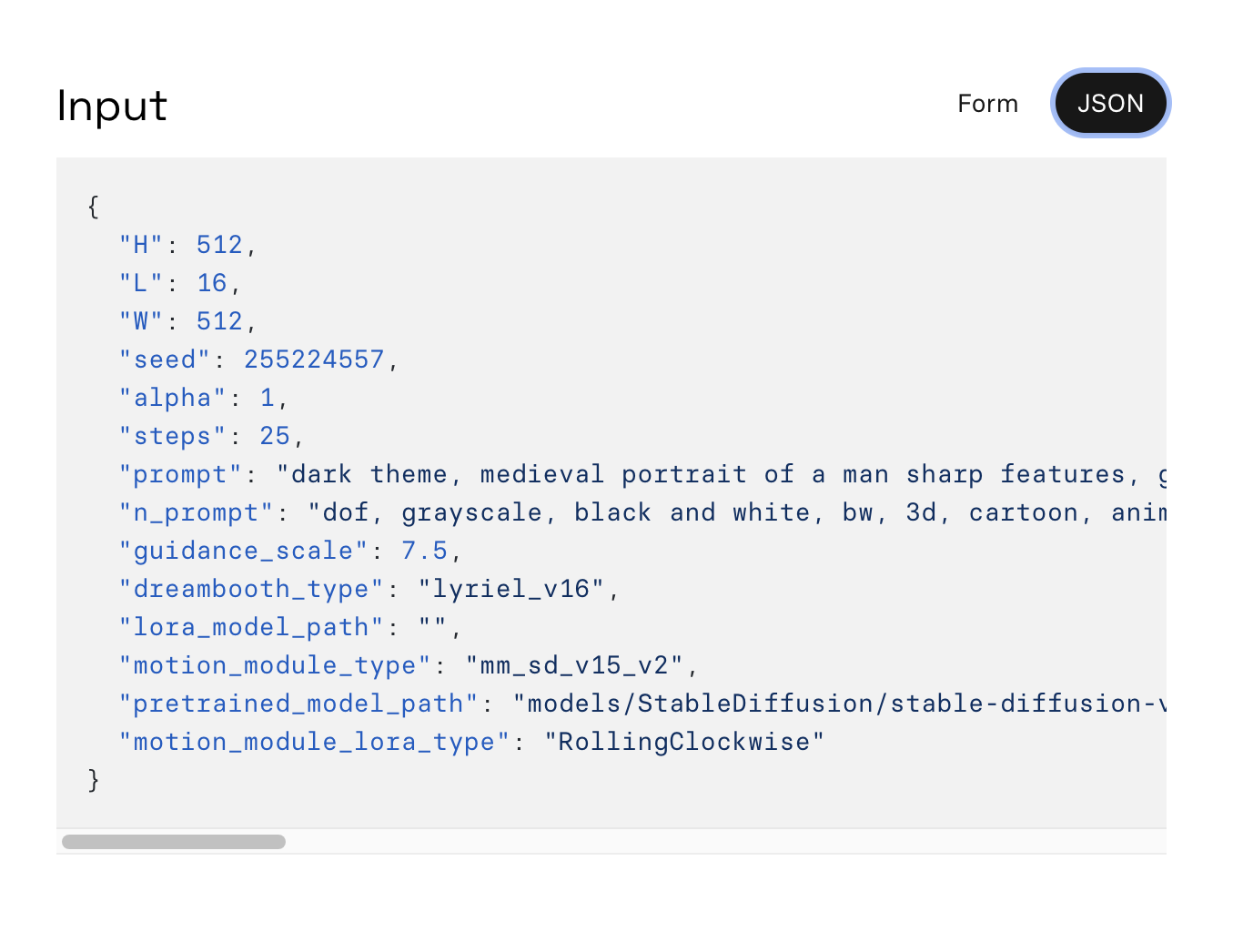
-
API for listing public models
October 5, 2023
Replicate’s API now has an endpoint for listing public models.
You can use it to discover newly published models, and to build your own tools for exploring Replicate’s ecosystem of thousands of open-source models.
cURL usage
Here’s an example that uses cURL and jq to fetch the URLs of the 25 most recently updated public models:
curl -s -H "Authorization: Token $REPLICATE_API_TOKEN" \ https://api.replicate.com/v1/models | jq ".results[].url"The response is a paginated JSON array of model objects:
{ "next": null, "previous": null, "results": [ { "url": "https://replicate.com/replicate/hello-world", "owner": "replicate", "name": "hello-world", "description": "A tiny model that says hello", "visibility": "public", "github_url": "https://github.com/replicate/cog-examples", "paper_url": null, "license_url": null, "run_count": 5681081, "cover_image_url": "...", "default_example": {...}, "latest_version": {...} } ] }JavaScript usage
We’ve added this new operation to the Replicate JavaScript client:
npm install replicate@latestThen:
import Replicate from "replicate"; const replicate = new Replicate(); // get recently published models const latestModels = await replicate.models.list(); console.log(latestModels) // paginate and get all models const allModels = [] for await (const batch of replicate.paginate(replicate.models.list)) { allModels.push(...batch); } console.log(allModels)Python usage
We’ve added this new operation to the Replicate Python client:
pip install --upgrade replicateThen:
import replicate models = replicate.models.list() print(models)Making your own models discoverable
If you’re deploying your own public models to Replicate and want others to be able to discover them, make sure they meet the following criteria:
- The model is public.
- The model has at least one published version.
- The model has at least one example prediction. To add an example, create a prediction using the web interface then click the “Add to examples” button below the prediction output.
-
Deployments
October 3, 2023
You can now create a deployment to get more control over how your models run. Deployments allow you to run a model with a private, fixed API endpoint. You can configure the version of the model, the hardware it runs on, and how it scales.
Using deployments, you can:
- Roll out new versions of your model without having to edit your code.
- Keep instances always on to avoid cold boots.
- Customize what hardware your models run on.
- Monitor whether instances are booting up, running, or processing predictions.
- View predictions that are flowing through your models.
Deployments work with both public models and your own private models.
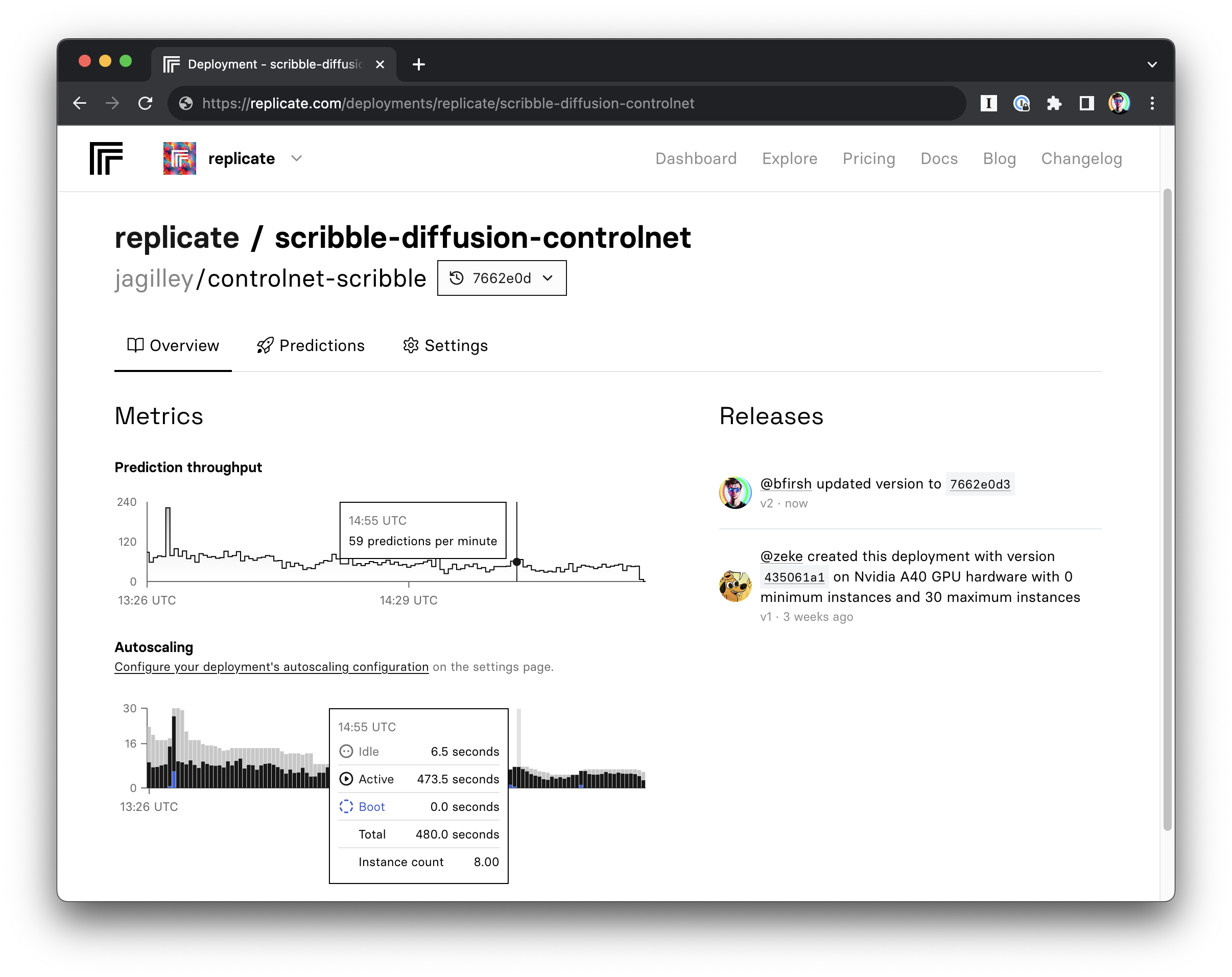
🚀 Check out the deployments guide to learn more and get started.
-
Prediction query parameter
October 2, 2023
When you create a prediction on the web, we now append a query parameter
?prediction=<uuid>, so that if you refresh the page, you see that prediction instead of the form prefilled with the default inputs. Previously, if you created a prediction on the web and refreshed, you’d lose the prediction and have to go spelunking for it on your dashboard. -
Fullscreen training logs
October 2, 2023
You can now expand your training logs and view them full-screen.
-
Dynamic status favicons
October 2, 2023
✅ We’ve added a new feature to show the prediction status in the favicon of the browser tab. This makes it easier to know when your running predictions have completed without having to switch tabs.
-
Streaming output for language models
August 14, 2023
Replicate’s API now supports server-sent event (SSE) streams for language models, giving you live output as the model is running. See the announcement blog post and our streaming guide for more details about how to use streaming output.
-
Multiple API tokens for users
August 10, 2023
You can now create multiple personal API tokens at https://replicate.com/account/api-tokens
They’re just like organization tokens, but they’re only for your personal user account. You can name your tokens to make them distinguishable, and reset them if needed.
-
A40 GPUs now available
July 24, 2023
You can now run Replicate models on NVIDIA A40 GPUs. In terms of price and performance, the A40 sits between our T4 and A100 hardware. For many models, the A40 Large can be 80-90% as fast as A100s but almost half the price.
The A40 GPU is currently available in two configurations, each with the same GPU but attached to a machine with different amounts of CPU and RAM:
Hardware Price GPU CPU GPU RAM RAM Nvidia A40 GPU $0.0013 per second ($0.078 per minute) 1x 4x 48GB 16GB Nvidia A40 (Large) GPU $0.0016 per second ($0.096 per minute) 1x 10x 48GB 72GB To choose which GPU type is used to run your model, see the Hardware dropdown on your model’s settings page:
To compare price and performance of all available GPUs, see our pricing page.
-
Hardware and pricing for trainable models
July 21, 2023
Trainable model pages now have a section that indicates training hardware type and cost.
See https://replicate.com/a16z-infra/llama7b-v2-chat#training
-
Training API for language models
July 20, 2023
We built a training API for fine-tuning language models, and today we’re making it available to all Replicate users.
You can fine-tune language models to make them better at a particular task, like classifying text, answering questions about your private data, being a chatbot, or extracting structured data from text.
You can train models like LLaMA 2, Flan T5, GPT-J and others. Check out the trainable language models collection to see what models can be fine-tuned, and stay tuned as we add support for more.
To get started, check out our guide to fine tuning a language model.
training = replicate.trainings.create( version="a16z-infra/llama7b-v2-chat:a845a72bb3fa3ae298143d13efa8873a2987dbf3d49c293513cd8abf4b845a83", input={ "train_data": "https://example.com/my-training-data.jsonl", }, destination="zeke/my-custom-llama-2" ) -
Git commit and tag for model versions
May 19, 2023
You can now see the Git commit and tag used to create new versions of a model. Run
brew upgrade cogto upgrade to the latest release.The next time you run
cog push, the current Git commit and tag for your model will automatically be included in the resulting Docker image, and it’ll show up on Replicate under the model page’s Versions tab. -
Downloading outputs
May 16, 2023
We’ve made a few improvements to the download mechanism on the website:
- If you ran a model that produces multiple outputs, you can download them all as a zip file.
- If you’re downloading a single output, it will now actually download instead of linking to the file’s URL.
Happy downloading!
-
Invoice breakdowns
May 16, 2023
You can now view a detailed summary of your invoices with a breakdown of cost, prediction time, and hardware for each model you ran.
Check out your billing settings at https://replicate.com/account/billing
-
Swift client library
May 9, 2023
Replicate now has a client library for Swift. It’s got everything you need to build an AI-powered app for iOS and macOS using Replicate’s HTTP API.
Add it as a package dependency to your project:
let package = Package( // name, platforms, products, etc. dependencies: [ // other dependencies .package(url: "https://github.com/replicate/replicate-swift", from: "0.12.1"), ], targets: [ .target(name: "<target>", dependencies: [ // other dependencies .product(name: "Replicate", package: "replicate-swift"), ]), // other targets ] )Then, you can run predictions:
import Replicate // Get your API token at https://replicate.com/account private let replicate = Replicate.Client(token: <#token#>) let output = try await replicate.run( "stability-ai/stable-diffusion:db21e45d3f7023abc2a46ee38a23973f6dce16bb082a930b0c49861f96d1e5bf", ["prompt": "a 19th century portrait of a wombat gentleman"] ) print(output) // ["https://replicate.com/api/models/stability-ai/stable-diffusion/files/50fcac81-865d-499e-81ac-49de0cb79264/out-0.png"]Follow our guide to building a SwiftUI app or read the full documentation on GitHub.
-
Organizations
May 3, 2023
You can now use an organization to collaborate with other people on Replicate.
Organizations let you share access to models, API tokens, billing, dashboards, and more. When you run models as the organization, it gets billed to your shared credit card instead of your personal account.
To get started, use the new account menu to create your organization:
-
Node.js client library
April 4, 2023
Replicate now has a client library for Node.js. You can use it to run models and everything else you can do with the HTTP API.
Install it from npm:
npm install replicateThen, you can run predictions:
import Replicate from "replicate"; const replicate = new Replicate({ auth: process.env.REPLICATE_API_TOKEN, }); const model = "stability-ai/stable-diffusion:27b93a2413e7f36cd83da926f3656280b2931564ff050bf9575f1fdf9bcd7478"; const input = { prompt: "a 19th century portrait of a raccoon gentleman wearing a suit" }; const output = await replicate.run(model, { input }); // ['https://replicate.delivery/pbxt/GtQb3Sgve42ZZyVnt8xjquFk9EX5LP0fF68NTIWlgBMUpguQA/out-0.png']Follow our guide to running a model from Node.js or read the full documentation on GitHub.
-
More useful metadata from the model API
March 21, 2023
The “get a model” API operation now returns more metadata about the model:
run_count: an integer indicating how many times the model has been run.default_example: a prediction object created with this model, and selected by the model owner as an example of the model’s inputs and outputs.cover_image_url: an HTTPS URL string for an image file. This is an image uploaded by the model author, or an output file or input file from the model’s default example prediction.
Here’s an example using cURL and jq to get the Salesforce blip-2 model as a JSON object and pluck out some of its properties:
curl -s \ -H "Authorization: Token $REPLICATE_API_TOKEN" \ -H 'Content-Type: application/json' \ "https://api.replicate.com/v1/models/salesforce/blip-2" \ | jq "{owner, name, run_count, cover_image_url, default_example}"Here’s what the response looks like:
{ "owner": "salesforce", "name": "blip-2", "run_count": 270306, "cover_image_url": "https://replicate.delivery/pbxt/IJEPmgAlL2zNBNDoRRKFegTEcxnlRhoQxlNjPHSZEy0pSIKn/gg_bridge.jpeg", "default_example": { "completed_at": "2023-02-13T22:26:49.396028Z", "created_at": "2023-02-13T22:26:48.385476Z", "error": null, "id": "uhd4lhedtvdlbnm2cyhzx65zpe", "input": { "image": "https://replicate.delivery/pbxt/IJEPmgAlL2zNBNDoRRKFegTEcxnlRhoQxlNjPHSZEy0pSIKn/gg_bridge.jpeg", "caption": false, "question": "what body of water does this bridge cross?", "temperature": 1 }, "logs": "...", "metrics": { "predict_time": 0.949567 }, "output": "san francisco bay", "started_at": "2023-02-13T22:26:48.446461Z", "status": "succeeded", "version": "4b32258c42e9efd4288bb9910bc532a69727f9acd26aa08e175713a0a857a608", } }See the “get a model” API docs for more details.
-
Get model input and output schemas via the API
March 20, 2023
Every model on Replicate describes its inputs and outputs with OpenAPI Schema Objects in the
openapi_schemaproperty. This is a structured JSON object that includes the name, description, type, and allowed values for each input or output parameter.Today we’ve improved our API reference documentation to clarify how to get a model’s input and output schema.
See the updated docs at https://replicate.com/docs/reference/http#models.versions.get
Here’s an example of how to get the input schema for Stable Diffusion using cURL:
curl -s \ -H "Authorization: Token $REPLICATE_API_TOKEN" \ -H 'Content-Type: application/json' \ "https://api.replicate.com/v1/models/stability-ai/stable-diffusion/versions/db21e45d3f7023abc2a46ee38a23973f6dce16bb082a930b0c49861f96d1e5bf" | jq ".openapi_schema.components.schemas.Input.properties"Using this command, we can see all the inputs to Stable Diffusion, including their types, description, min and max values, etc:
{ "seed": { "type": "integer", "title": "Seed", "x-order": 7, "description": "Random seed. Leave blank to randomize the seed" }, "prompt": { "type": "string", "title": "Prompt", "default": "a vision of paradise. unreal engine", "x-order": 0, "description": "Input prompt" }, "scheduler": { "allOf": [ { "$ref": "#/components/schemas/scheduler" } ], "default": "DPMSolverMultistep", "x-order": 6, "description": "Choose a scheduler." }, "num_outputs": { "type": "integer", "title": "Num Outputs", "default": 1, "maximum": 4, "minimum": 1, "x-order": 3, "description": "Number of images to output." }, "guidance_scale": { "type": "number", "title": "Guidance Scale", "default": 7.5, "maximum": 20, "minimum": 1, "x-order": 5, "description": "Scale for classifier-free guidance" }, "negative_prompt": { "type": "string", "title": "Negative Prompt", "x-order": 2, "description": "Specify things to not see in the output" }, "image_dimensions": { "allOf": [ { "$ref": "#/components/schemas/image_dimensions" } ], "default": "768x768", "x-order": 1, "description": "pixel dimensions of output image" }, "num_inference_steps": { "type": "integer", "title": "Num Inference Steps", "default": 50, "maximum": 500, "minimum": 1, "x-order": 4, "description": "Number of denoising steps" } }And here’s a command to the get the output schema:
curl -s \ -H "Authorization: Token $REPLICATE_API_TOKEN" \ -H 'Content-Type: application/json' \ "https://api.replicate.com/v1/models/stability-ai/stable-diffusion/versions/db21e45d3f7023abc2a46ee38a23973f6dce16bb082a930b0c49861f96d1e5bf" | jq ".openapi_schema.components.schemas.Output"From this command, we can see that Stable Diffusion output format is a list of URL strings:
{ "type": "array", "items": { "type": "string", "format": "uri" }, "title": "Output" } -
OpenAPI schema for the public API
February 16, 2023
OpenAPI (formerly known as Swagger) is a specification for describing HTTP APIs with structured data, including the available endpoints, their HTTP methods, expected request and response formats, and other metadata.
You can use this schema as a reference document, or to auto-generate your own API client code, or to mock and test your existing use of Replicate’s API.
All of the documentation you see on the HTTP API reference page is also available as a structured OpenAPI JSON schema.
Download the schema at api.replicate.com/openapi.json
-
See more models
February 15, 2023
You can now browse through all the models on Replicate. Check them out on the Explore page!

-
Improved webhook events and event filtering
February 10, 2023
When you create a prediction with the API, you can provide a webhook URL for us to call when your prediction is complete.
Starting today, we now send more webhook events at different stages of the prediction lifecycle. We send requests to your webhook URL whenever there are new logs, new outputs, or the prediction has finished.
You can change which events trigger webhook requests by specifying
webhook_events_filterin the prediction request.start: Emitted immediately on prediction start. This event is always sent.output: Emitted each time a prediction generates an output (note that predictions can generate multiple outputs).logs: Emitted each time log output is generated by a prediction.completed: Emitted when the prediction reaches a terminal state (succeeded/canceled/failed). This event is always sent.
For example, if you only wanted requests to be sent at the start and end of the prediction, you would provide:
{ "version": "5c7d5dc6dd8bf75c1acaa8565735e7986bc5b66206b55cca93cb72c9bf15ccaa", "input": { "text": "Alice" }, "webhook": "https://example.com/my-webhook", "webhook_events_filter": ["start", "completed"] }Requests for event types
outputandlogswill be sent at most once every 500ms.Requests for event types
startandcompletedwill always be sent.If you’re using the old
webhook_completed, you’ll still get the same webhooks as before, but we recommend updating to use the newwebhookandwebhook_completedproperties.Docs: https://replicate.com/docs/reference/http#create-prediction–webhook
-
Python example code improvements
January 19, 2023
We’ve made it even easier to start building with Replicate’s API. When you click on the API tab for a model, the Python example code now has everything you need to run a prediction, including code for all of the model’s inputs and outputs. These new code snippets include documentation and defaults for each input, so you can focus on coding, with less context switching between the API docs and your editor.
To learn more about how to get started, check out our “Run a model from Python” guide.

-
Cancel long running predictions
January 16, 2023
Have you ever kicked off a prediction, then, after thinking about it, realized you got one of the settings wrong or wanted to tweak the prompt? Well, now you can cancel that prediction, even if you’ve navigated away from the page you were on or made it through the API. On the website, go to your dashboard, find the running prediction, and you’ll now see it live-updating with a handy “Cancel” button.

-
brew install cog
January 10, 2023
🍏 Hey macOS users! There’s now a Homebrew formula for Cog. Use
brew install cogto install it, andbrew upgrade cogto upgrade to the latest version. See https://github.com/replicate/cog#install -
Dreambooth support for img2img
January 9, 2023
We’ve added img2img support to models created with our DreamBooth API.
This means you can optionally send both a
promptand initialimageto generate new images (in addition to the other parameters specified in your DreamBooth model’s API page).Input:
prompt: photo of zeke playing guitar on stage at concertimage: https://www.pexels.com/photo/man-playing-red-and-black-electric-guitar-on-stage-167382/
Output:

To get started building and pushing your own DreamBooth model, check out the blog post.
-
Delete predictions from the web
January 6, 2023
You can now manually delete a prediction on the website. You’ll find a “Delete” button on the prediction detail page, e.g.
https://replicate.com/p/{prediction_id}. Clicking this link will completely remove the prediction from the site, including any output data and output files associated with it.
-
API prediction data no longer stored
January 4, 2023
By popular request, we no longer store data for predictions made using the API.
User data is automatically removed from predictions an hour after they finish. The prediction itself is not deleted, but the
inputandoutputdata for the prediction is removed. This only applies to predictions created with the API, but not predictions created on the website.This is enabled for new accounts starting today, but we know that some users may be relying on prediction data to exist for more than an hour, so we’ve not enabled this for any existing accounts.
-
A proper changelog
December 6, 2022
We now have a changelog for product updates at replicate.com/changelog. We used to use a single tweet thread as our makeshift changelog, but decided it was time to make something a bit more flexible. Stay tuned for more frequent updates here!
-
Stable diffusion has release notes
December 2, 2022
Stable Diffusion now has release notes so you can see what’s changed: replicate.com/stability-ai/stable-diffusion/versions. It only works on Stable Diffusion at the moment. Coming soon to all models so you can set release notes on your own models and see what has changed on other people’s models.
-
Infrastructure improvements
November 4, 2022
Over the past few weeks, we’ve made some major improvements to our infrastructure to make it more reliable and perform better. Nothing’s changed from your point of view, but you’ll be seeing faster response times! 🚀
-
Higher rate limits
November 4, 2022
We’ve also increased our default rate limits. You can create 10 predictions a second, bursting up to 600 predictions a second. https://replicate.com/docs/reference/http#rate-limits
We can support higher rates too – just email us: team@replicate.com
-
Run your own models on Nvidia A100 GPUs
October 19, 2022
You can now run your own models on Nvidia A100s. Click the settings tab on your model and select the hardware option to upgrade. 🚀
-
Set a monthly spend limit
October 17, 2022
You can now set a monthly spend limit on your account to avoid getting a surprising bill. 🦆
To set a limit, visit https://replicate.com/account#limits
-
Webhook support in Predictions API
September 9, 2022
🪝 Our API now supports webhooks, as an alternative to polling. Specify your webhook URL when creating a prediction and we’ll POST to that URL when your prediction has completed! See the API docs here: https://replicate.com/docs/reference/http#create-prediction
-
Introducing model collections
June 16, 2022
“We’ve started curating collections of models that perform similar tasks. First up is an assortment of ✨style transfer✨ models that take a content image and a style reference to produce a new image, like this starry night cat. https://replicate.com/collections/style-transfer
-
Scrubbing support for progressive outputs
March 28, 2022
“When you run a model that changes over time, you can scrub back and forth to see the previous output. We’ve now added that scrubber to predictions in the example gallery, so you can see how they morphed into being: https://replicate.com/pixray/text2image/examples
